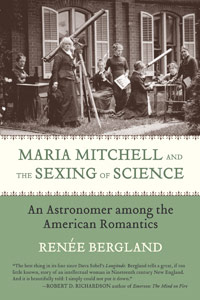 Those of you who have followed my blogging know that I’m crazy about old astronomy books. My personal fetish is first-edition, 19th-century books in English. But within my library, my favorite subcollection is astronomy books written by 19th-century women. Women astronomers and science writers of this period were pioneers, and titles by them are uncommon.
Those of you who have followed my blogging know that I’m crazy about old astronomy books. My personal fetish is first-edition, 19th-century books in English. But within my library, my favorite subcollection is astronomy books written by 19th-century women. Women astronomers and science writers of this period were pioneers, and titles by them are uncommon.
One of the women represented in my collection is American astronomer Maria Mitchell (1818–1889). Now a new book by Renée Bergland, Maria Mitchell and the Sexing of Science: An Astronomer among the American Romantics (Beacon Press, 2008), tells Mitchell’s story.
Born and raised in Nantucket, Massachusetts, Mitchell apprenticed with her father, who was an amateur astronomer. Mitchell would spend evenings sweeping the sky, and, in 1847, she discovered a comet now designated C/1847 T1 that would lead to international recognition. With this discovery, Mitchell became only the second woman to have found a comet. The other, English astronomer Caroline Herschel (1750–1848), was already a household name among 19th-century astronomers.
Mitchell later joined the staff of the United States Nautical Almanac, where she calculated tables of Venus’ position. In 1865, she became the first woman professor at Vassar College and the director of the Vassar College Observatory.
Unfortunately, her career at Vassar was a sad one. Mitchell, who usually made friends easily, found a male faculty unwilling to accept her. Bergland also tells how Mitchell watched as opportunities for female students vanish as science went from a private pursuit to an increasingly male-dominated profession.
Maria Mitchell and the Sexing of Science presents a slice of history that bears remembering. It’s only in recent years that science has once again embraced the female part of the equation.